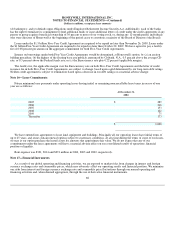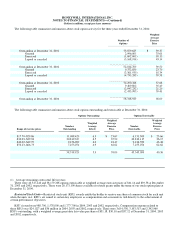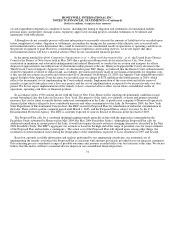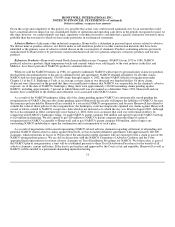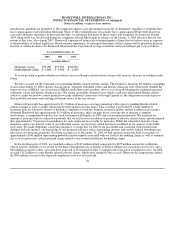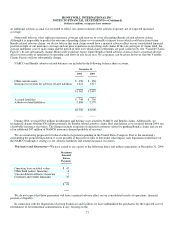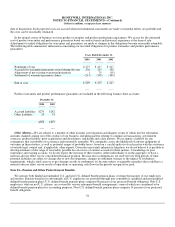Honeywell 2004 Annual Report Download - page 96
Download and view the complete annual report
Please find page 96 of the 2004 Honeywell annual report below. You can navigate through the pages in the report by either clicking on the pages listed below, or by using the keyword search tool below to find specific information within the annual report.
HONEYWELL INTERNATIONAL INC.
NOTES TO FINANCIAL STATEMENTS—(Continued)
(Dollars in millions, except per share amounts)
of cash expenditures depends on a number of factors, including the timing of litigation and settlements of remediation liability,
personal injury and property damage claims, regulatory approval of cleanup projects, remedial techniques to be utilized and
agreements with other parties.
Although we do not currently possess sufficient information to reasonably estimate the amounts of liabilities to be recorded upon
future completion of studies, litigation or settlements, and neither the timing nor the amount of the ultimate costs associated with
environmental matters can be determined, they could be material to our consolidated results of operations or operating cash flows in
the periods recognized or paid. However, considering our past experience and existing reserves, we do not expect that these
environmental matters will have a material adverse effect on our consolidated financial position.
In the matter entitled Interfaith Community Organization, et al. v. Honeywell International Inc., et al., the United States District
Court for the District of New Jersey held in May 2003 that a predecessor Honeywell site located in Jersey City, New Jersey
constituted an imminent and substantial endangerment and ordered Honeywell to conduct the excavation and transport for offsite
disposal of approximately one million tons of chromium residue present at the site. Honeywell appealed the Court's decision to the
Third Circuit Court of Appeals (Appeals Court). As disclosed in prior SEC filings, we believed that the District Court-ordered remedy
would be remanded, reversed or replaced and, accordingly, provisions previously made in our financial statements for remedial costs
at this site did not assume excavation and offsite removal of chromium. On February 18, 2005, the Appeals Court denied Honeywell's
appeal. In light of the Appeals Court decision, we recorded a pre-tax charge of $278 million in the fourth quarter of 2004, which
reflects the incremental cost of implementing the Court-ordered remedy. Implementation of the excavation and offsite removal
remedy is expected to take place over a five-year period, and the cost of implementation is expected to be incurred evenly over that
period. We do not expect implementation of the remedy to have a material adverse effect on our future consolidated results of
operations, operating cash flows or financial position.
In accordance with a 1992 consent decree with the State of New York, Honeywell is studying environmental conditions in and
around Onondaga Lake (the Lake) in Syracuse, New York. The purpose of the study is to identify, evaluate and propose remedial
measures that can be taken to remedy historic industrial contamination in the Lake. A predecessor company to Honeywell operated a
chemical plant which is alleged to have contributed mercury and other contaminants to the Lake. In November 2004, the New York
State Department of Environmental Conservation (the DEC) issued its Proposed Plan for remediation of industrial contamination in
the Lake. There will be a public comment period until March 1, 2005, and the Proposed Plan is subject to review by the U.S.
Environmental Protection Agency. The DEC is currently expected to issue its Record of Decision in the first half of 2005.
The Proposed Plan calls for a combined dredging/capping remedy generally in line with the approach recommended in the
Feasibility Study submitted by Honeywell in May 2004 (the May 2004 Feasibility Study). Although the Proposed Plan calls for
additional remediation in certain parts of the Lake, it would not require the most extensive dredging alternatives described in the May
2004 Feasibility Study. The DEC's aggregate cost estimate is based on the high end of the range of potential costs for major elements
of the Proposed Plan and includes a contingency. The actual cost of the Proposed Plan will depend upon, among other things, the
resolution of certain technical issues during the design phase of the remediation, expected to occur sometime in 2007 and beyond.
Based on currently available information and analysis performed by our engineering consultants, our estimated cost of
implementing the remedy set forth in the Proposed Plan is consistent with amounts previously provided for in our financial statements.
Our estimating process considered a range of possible outcomes and amounts recorded reflect our best estimate at this time. We do not
believe that this matter will have a material adverse impact on our consolidated financial position.
72




